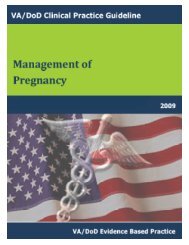DM Full Guideline (2010) - VA/DoD Clinical Practice Guidelines Home
DM Full Guideline (2010) - VA/DoD Clinical Practice Guidelines Home
DM Full Guideline (2010) - VA/DoD Clinical Practice Guidelines Home
You also want an ePaper? Increase the reach of your titles
YUMPU automatically turns print PDFs into web optimized ePapers that Google loves.
Version 4.0<br />
<strong>VA</strong>/<strong>DoD</strong> <strong>Clinical</strong> <strong>Practice</strong> <strong>Guideline</strong><br />
for the Management of Diabetes Mellitus<br />
resolved, the patient should be referred to a foot care specialist for intensive secondary prevention (Conte et al.,<br />
1995; Currie et al., 1995).<br />
Initial therapy could include antibiotics, wound cleansing, tetanus prophylaxis (if indicated), and/or same-day<br />
referral to a foot care specialist.<br />
Patients with diabetes, especially neuropathic patients, often present late for treatment with mixed aerobic and<br />
anaerobic infections that require prompt referral and evaluation by a qualified provider who is experienced in the<br />
management of this condition (Lavery et al., 1995).<br />
EVIDENCE<br />
Recommendation Sources LE QE SR<br />
1 Referral for limb-threatening<br />
conditions.<br />
2 Referral to a vascular specialist for<br />
symptoms that limit lifestyle.<br />
Working Group Consensus III Poor I<br />
Conte et al., 1995<br />
Currie et al., 1995<br />
Lavery et al., 1995<br />
LE-Level of Evidence; QE = Quality of Evidence; SR = Strength of Recommendation (see Appendix A).<br />
E. Is Patient at High-Risk for a Foot Problem?<br />
OBJECTIVE<br />
Identify the patient at high-risk for LE foot ulcers and amputations.<br />
RECOMMENDATIONS<br />
1. Patients without limb-threatening conditions should be evaluated for their level of risk for LE foot ulcers<br />
and amputations.<br />
2. The existence of one of the following characteristics is sufficient to define the patient as high-risk for foot<br />
problem.<br />
• Lack of sensation to Semmes-Weinstein 5.07 monofilament at one or more noncallused plantar sites<br />
• Evidence of LE arterial disease (absence of both dorsalis pedis and tibialis posterior pulses, dependent<br />
rubor with pallor on elevation, history of rest pain or claudication, and prior history of LE bypass<br />
surgery)<br />
• Foot deformities (specifically hammer toes, claw toe, Charcot's arthropathy, bunions, and metatarsal<br />
head deformities)<br />
• History of foot ulcer or non-traumatic LEA at any level.<br />
3. The patient at high-risk should be referred to a foot care specialist for a more comprehensive evaluation and<br />
intensive treatment plan including patient education concerning foot care practices, hygiene, and footwear.<br />
A foot care specialist is defined as a podiatrist, vascular surgeon, orthopedic surgeon, or other healthcare provider<br />
with demonstrated training, competence, and licensure in foot care.<br />
III<br />
II<br />
III<br />
Poor<br />
I<br />
Module F – Foot Care Page 100
















